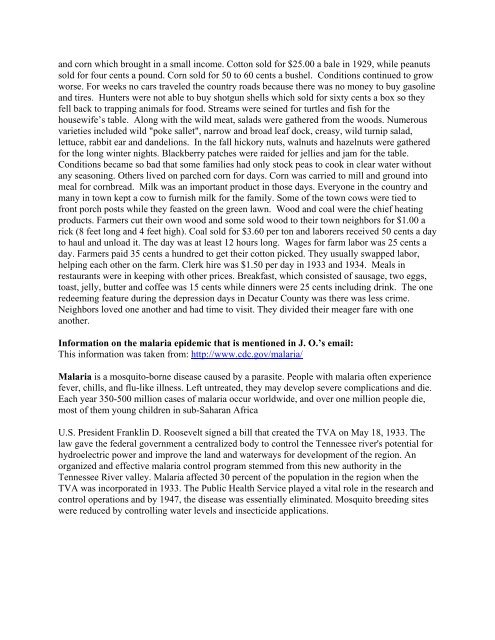Memories of Wallace Heritage - Official website of Rev. JO Wallace
Memories of Wallace Heritage - Official website of Rev. JO Wallace
Memories of Wallace Heritage - Official website of Rev. JO Wallace
Create successful ePaper yourself
Turn your PDF publications into a flip-book with our unique Google optimized e-Paper software.
and corn which brought in a small income. Cotton sold for $25.00 a bale in 1929, while peanuts<br />
sold for four cents a pound. Corn sold for 50 to 60 cents a bushel. Conditions continued to grow<br />
worse. For weeks no cars traveled the country roads because there was no money to buy gasoline<br />
and tires. Hunters were not able to buy shotgun shells which sold for sixty cents a box so they<br />
fell back to trapping animals for food. Streams were seined for turtles and fish for the<br />
housewife’s table. Along with the wild meat, salads were gathered from the woods. Numerous<br />
varieties included wild "poke sallet", narrow and broad leaf dock, creasy, wild turnip salad,<br />
lettuce, rabbit ear and dandelions. In the fall hickory nuts, walnuts and hazelnuts were gathered<br />
for the long winter nights. Blackberry patches were raided for jellies and jam for the table.<br />
Conditions became so bad that some families had only stock peas to cook in clear water without<br />
any seasoning. Others lived on parched corn for days. Corn was carried to mill and ground into<br />
meal for cornbread. Milk was an important product in those days. Everyone in the country and<br />
many in town kept a cow to furnish milk for the family. Some <strong>of</strong> the town cows were tied to<br />
front porch posts while they feasted on the green lawn. Wood and coal were the chief heating<br />
products. Farmers cut their own wood and some sold wood to their town neighbors for $1.00 a<br />
rick (8 feet long and 4 feet high). Coal sold for $3.60 per ton and laborers received 50 cents a day<br />
to haul and unload it. The day was at least 12 hours long. Wages for farm labor was 25 cents a<br />
day. Farmers paid 35 cents a hundred to get their cotton picked. They usually swapped labor,<br />
helping each other on the farm. Clerk hire was $1.50 per day in 1933 and 1934. Meals in<br />
restaurants were in keeping with other prices. Breakfast, which consisted <strong>of</strong> sausage, two eggs,<br />
toast, jelly, butter and c<strong>of</strong>fee was 15 cents while dinners were 25 cents including drink. The one<br />
redeeming feature during the depression days in Decatur County was there was less crime.<br />
Neighbors loved one another and had time to visit. They divided their meager fare with one<br />
another.<br />
Information on the malaria epidemic that is mentioned in J. O.’s email:<br />
This information was taken from: http://www.cdc.gov/malaria/<br />
Malaria is a mosquito-borne disease caused by a parasite. People with malaria <strong>of</strong>ten experience<br />
fever, chills, and flu-like illness. Left untreated, they may develop severe complications and die.<br />
Each year 350-500 million cases <strong>of</strong> malaria occur worldwide, and over one million people die,<br />
most <strong>of</strong> them young children in sub-Saharan Africa<br />
U.S. President Franklin D. Roosevelt signed a bill that created the TVA on May 18, 1933. The<br />
law gave the federal government a centralized body to control the Tennessee river's potential for<br />
hydroelectric power and improve the land and waterways for development <strong>of</strong> the region. An<br />
organized and effective malaria control program stemmed from this new authority in the<br />
Tennessee River valley. Malaria affected 30 percent <strong>of</strong> the population in the region when the<br />
TVA was incorporated in 1933. The Public Health Service played a vital role in the research and<br />
control operations and by 1947, the disease was essentially eliminated. Mosquito breeding sites<br />
were reduced by controlling water levels and insecticide applications.


